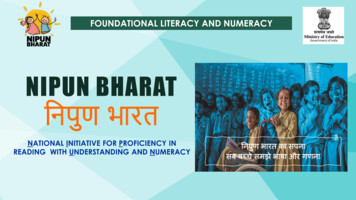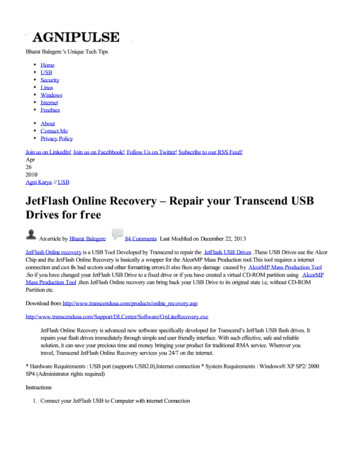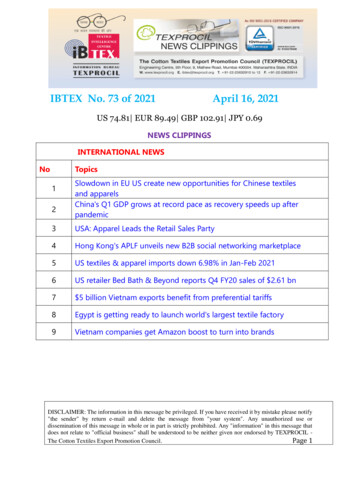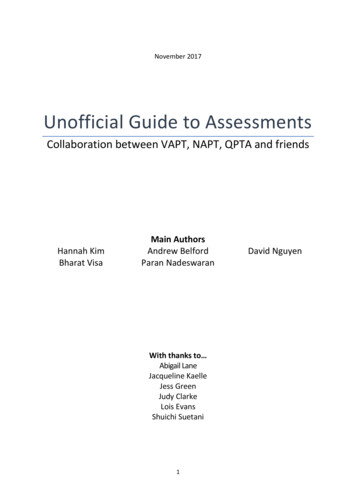
Transcription
FOUNDATIONAL LITERACY AND NUMERACYNIPUN BHARATनिपु ण भारतNATIONAL INITIATIVE FOR PROFICIENCY INREADING WITH UNDERSTANDING AND NUMERACYनिपुण भारत का सपिासब बच्चे समझे भाषा और गणिा
NEP, 2020: augmenting student learning outcomes through FLNRecognizing the importance of early learning, the National Education Policy 2020 states that “Ourhighest priority must be to achieve universal foundational literacy and numeracy (FLN) in primaryschool and beyond by 2025. The rest of the policy will be largely irrelevant for such a large portion ofour students if this most basic learning (reading, writing, and arithmetic at the foundational level) is notfirst achieved.”Launching a NationalMission on FoundationalLiteracy and NumeracyMaking foundationallearning the highestpriority for the countryAchieving universal FLNin primary schools by2026-27
The highest priority of school education will be “Universal acquisitionof Foundational learning skills by Grade 3”Higher order learningCHILDREN WHO FALL BEHIND, GET LEFT BEHINDGrade 3 is the inflection point by which children are expected to“learn to read” so that they can “read to learn” after that.Better learning OutcomesFoundational SkillsThe Education system aims to achieve Foundational Literacy and Numeracy by 2026-27, where,by Grade 3 every child can .Read withComprehensionWriteBasic MathematicalOperationsLearn basic life skills
What is FoundationalLiteracy and Numeracy?
Oral Language DevelopmentIncludes improved listening comprehension; oral vocabularyand extended conversation skills. The experiences in orallanguage are important for developing skills of reading andwriting.DecodingFOUNDATIONALLANGUAGE AND LITERACYThe pre-existing knowledgeof language helps in buildingliteracy skills in languages.The key components inFoundational Language andLiteracy are:Involves deciphering written words based on understandingthe relationship between symbols and their soundsReading FluencyRefers to the ability to read a text with accuracy, speed(automaticity), expression (prosody), and comprehension thatallows children to make meaning from the text. Many childrenrecognise aksharas, but read them laboriously, one-by-one.Reading ComprehensionInvolves constructing meaning from a text and thinkingcritically about it. This domain covers the competencies ofunderstanding texts and retrieving information from them, aswell as interpreting texts.WritingThis domain includes the competencies of writing aksharas andwords as well as writing for expression
Pre-number conceptsCount and understand the number systemNumbers and operations on ns the ability to reasonandtoapplysimplenumerical concepts in dailylife problem solving. Themajoraspectsandcomponentsofearlymathematics are:Learn conventions needed for mastery ofMathematical techniques such as the use of a baseten system to represent numbersShapesandSpatialUnderstandingPerform simple computations in her/his own way upto three-digit numbers and apply these to their dayto life activities in different contextsMeasurementUnderstand and use standard algorithms to performoperations of addition, subtraction, multiplicationand division on numbers up to three digitsData HandlingIdentify and extend simple patterns starting fromrepeating shapes to patterns in numbers, interpretsimple data/information in his/her daily life activities
National Mission: NIPUN BHARAT VisionThe vision of the Mission is to create an enablingenvironment to ensure universal acquisition offoundational literacy and numeracy, so that by2026-27 every child achieves the desiredlearning competencies in reading, writing andnumeracy at the end of Grade III and not laterthan Grade V.
National Mission: OBJECTIVES of the MissionThe programme will be implemented in the mission mode, with the use and strengthening of the existing mainstream structures. TheDepartment of School Education and Literacy, Ministry of Education (MoE) will be the implementing agency at the national level andwill be headed by a Mission Director:43To ensure availability and effectiveusage of high-quality and culturallyresponsive teaching learning materialin children‟s familiar/home/motherlanguage(s).To make children understand thereasoning in the domains of number,measurement, and shapes; andenable them to becomeindependent in problem solving byway of numeracy and spatialunderstanding skills.5To focus on continuous capacitybuilding of teachers, head teachers,academic resource persons andeducation administrators.26To enable children to becomemotivated, independent, andengaged readers and writers withcomprehension possessingsustainable reading and writing skills.1To ensure an inclusive classroomenvironment by incorporating play,discovery, and activity-basedpedagogies, linking it to the daily lifesituations of the children and formalinclusion of children‟s homelanguages.To actively engage with allstakeholders i.e., Teachers, Parents,Students and Community, policymakers for building a strongfoundation of lifelong learning.7To ensure assessment „as, of and for‟learning through portfolios, groupand collaborative work, project work,quizzes, role plays, games, oralpresentations, short tests, etc.8To ensure tracking of learninglevels of all students.
Academicapproaches
The Learning outcomes for Foundational learning have been dividedinto 3 Development goalsThe Learning outcomes for Foundational learning have beendivided into 3 three developmental goals: Goal 1-HW (Health andWellbeing), Goal 2-EC (Effective Communicators), Goal 3-IL(Involved Learners). Key competencies of each goal have alsobeen identified.Health and Wellbeing (HW)EffectiveCommunication(EC)Holistic Developmentof a childGoal 1: Childrenmaintain goodhealth and wellbeingGoal 2: ChildrenbecomeeffectivecommunicatorsGoal 3: Childrenbecome evolvedlearners andconnect withtheir PETENCIESLearningOutcomes: Oneor more LOs foreverycompetencyLearningOutcomes: Oneor more LOs foreverycompetencyLearningOutcomes: Oneor more LOs foreverycompetencyInvolvedLearners (IL) The developmental goals have been further divided into sixlevels corresponding to the 3 years of ECCE followed by 3years of schooling.Each learning outcome has been given a number/code foreasy identification and referencing. It is important tounderstand that these numbers are not hierarchical, but theseexperiences can be provided simultaneously in an integratedway.
Lakshyas: Learning Goals of the MissionThe National Mission will declare the overall national targets in achievinglearning outcomes, including year wise outcomes to be achieved by theyear 2026-27 by each State/UT. The overall literacy and numeracy targetsto achieve the objectives of the Mission are set in the form of Lakshya orTargets for Foundational Literacy and Numeracy starting from theBalvatika. Recognises letters andcorresponding sounds Reads simple wordscomprising of at least 2to 3 alphabets. Recognizes and readsnumerals up to 10. Arrangesnumbers/objects/shapes/occurrence of events ina sequenceBalvatika Reads smallsentences consistingof at least 4-5 simplewords in an ageappropriate unknowntext. Readandwritenumbers up to 99 Perform simpleaddition andsubtractionGrade 1 Read with meaning 45-60 words perminute Read and writenumbers up to 999Subtract numbers upto 99Grade 2 Read with meaning at least 60 words perminute Read and write numbersup to 9999 Solve simplemultiplication problemsGrade 3
Learning AssessmentsAssessment is vital to track children‟s progress in a continuous and comprehensive manner using multiple techniques of assessment.It aims at early identification of learning gaps at each foundational stage i.e., at FYL-1, FYL-2, FYL-3, FYL-4, FYL-5 and FYL-6 includingchildren with special needs so that there can be possibilities of early intervention through referral to specialists.A holistic and purposive assessment is vital to track children‟s progress by using different techniques to help thestakeholders to:Identify thechild‟sstrengths,needs,interests andpreferences.Assessment duringthe foundationallearning can bebroadly categorizedinto two majorareas, namelyPotentiatechild‟sperformanceand scaffoldit throughinterventionsCollaborateto solveissues andareas ofconcerns.School Based Assessment (SBA)SBA at the foundational stageshould be stress-free and largelythrough qualitative observationbased on performance of thechild in a multitude ofexperiences and activitiesContribute toearlyidentification oflearning gapsand learningdifficultiesLarge-scale standardisedassessmentLarge scale assessment data atthe State, National or theInternational level focuses on the„System‟ and describes theeducational health of the nation,state or district.
Pedagogy for creating aninclusive classroomContextualisation materials keeping in view thelinguistic and social diversity of each State/UT Emphasis on Child CentredPedagogyEmphasisoninteractiveclassroom including authentic,appropriate, and accessible toysand materials. Toy-based pedagogy Activitylearning Play based Art-integrated/sport-integrated Story-telling-based ICT-integrated learning based/experiential
Empowering TeachersIn view of the challenges of in-serviceteacher training across the differentstages of school education, NCERT hasdesigned an innovative integratedprogramme of teacher training, now,popularly known as NISHTHA (NationalInitiative for School Heads‟ andTeachers‟ Holistic Advancement)Specific Teacher Training Modulesfocusing on FL&N will be designedthrough NISHTHAFLN-NISHTHA modules will specificallycontain a module on bridging thelanguage barrier and teaching inmothertongue/regionallanguage/home language.FLN-NISHTHA will contain a specificmodule on peer learning and howparents can be utilized as volunteers inthe schools.
Expanding the scope and use of DIKSHA for FLNUsing DIKSHA to enable Student Learning: range from explanation videos, interactiveassessment items, worksheets, reading materials, etc. will be availableLITERACY CONTENTNUMERACY CONTENT01Read Along –digital read-along material.01Explanation Video Type02Reading Comprehension02Short videos clarifying misconceptions03Grammar Question Bank03Real World Example Videos04Children‟s literature- local lore and folk tales04Assessment BanksUsing DIKSHA to enable Teacher Professional DevelopmentVarious teacher training resources including: Training modules Supportive materials for the training sessions, like hand-outs, videos, reading resources, Teaching-learning materials Instructional strategies, teacher handbook, activity booklets etc. will also be made available.
School Preparation Module85% of a child's brain develops before the age of 6NEP-2020 has recommended the development of „3-month play-based„school preparation module‟ for all Grade 1 Students‟ by the NCERT, asan interim measure to ensure that all children are school ready tilluniversal provisioning of quality preschool education is achieved. A School Preparation Module (SPM) is essentially around 12 weeks ofdevelopmentally appropriate instruction at the beginning of Class Idesigned to bolster a child‟s pre-literacy, pre-numeracy, cognitive andsocial skills.It is expected that this module would consist of the activities andworkbooks around the learning of alphabets, sounds, words, colours,shapes, and numbers, and involving collaborations with peers and parents.Accordingly, theNCERT hasdeveloped 3 MonthsPlay Based „SchoolPreparation Module‟that can beadapted or adoptedby States and UTs asper their need
AdministrativeApproaches
National Mission: Implementation MechanismA five-tier Implementation mechanism for the Mission will be set up at theNATIONAL-STATE-DISTRICT-BLOCK-SCHOOL levelNational MissionState MissionDistrict MissionBlock/Clusterlevel missionSchool ManagementCommittee &Communityparticipation
Role of various Stakeholders& Institutions in the Mission
Role of States/UTsStates and UTs have a criticalrole to play to achieve the goalof foundational literacy andnumeracy by 2025-26, in missionmode. The following activitieswould need to be ensured:Creating multi-year Actionplanstoachievetheirrespective FLN targets.Contextualise the NationalMission by preparing statespecific Stage-wise ActionPlan based on gaps identifiedin NAS.EnsureavailabilityofadequatenumberofTeachers in each school ateach grade from pre-primaryto grade 3 and extensivecapacity building of teachersfor implementing FLN inmission mode.Mapping of databaseeachchildenrolledfoundational grades.Identify a pool of mentors torender academic support toteachers.Ensuring delivery of textbooksand uniforms to studentsbefore the start of academicsession.ofinSchool/public libraries will bemadeintegralpartofteaching learning process.Training of SMC members,awareness drives for parentsand community to makethem understand the desiredlevel of learning outcome.
“It takes a village toraise a child” A successful mission to improvefoundational learning of all children inour country cannot be envisagedwithout an active role played byseveral Institutions, Teachers, Parents,Community, Local Bodies, etc. Each stakeholder plays a valuable rolein the mission
CommunityInvolvementLocalBodies/PanchayatsOrganise various activities supported by teacher &Aanganwadi sevika/sahayika i.e. School readiness melas Gunotsava/ Pravashotsav for children and their mothers: Reading, quiz competitions, awards and recognitionsThis will encourageinvolvement.childrenandensurecommunity Undertake Baseline analysis as prescribed by the State to identifystruggling learners and status school/class wise. Ensuring 100% enrolment of all children in the Panchayat in schools atappropriate levels. Ensuring ZERO drop out and NO out of school children. Ensuring all children in foundational years achieve basic minimumproficiency in Literacy and Numeracy. Connecting volunteer parents to schools to help the school achievethe FLN goals.
Monitoring and Information Technology Framework The Mission at the National level, State Level and district level will monitor Missionactivities through IT based solutions which shall include field level child wise monitoring. The monitoring framework proposed will essentially be of two types:o Annual Monitoring Surveys ando Concurrent Monitoring. Further, the priorities for FLN are stated in the goals and these can be achieved by leveraging theexisting building blocks such as DIKSHA and UDISE , which may be enhanced by leveraging opensource tools and solutions for registries and identities while at the same time following the principlesand standards set down by NDEAR, as per the following:NDEAR institutional framework led by MoEmay identify the areas where standards,specifications and policies need to be putin place in order to achieve the abovementioned policy goals.The framework and architecture for the FLNData collection and measurement shouldenable automatic data collection andcollation from multiple sources and atdifferent frequencies and levels without needfor special collection drives, pulling of datafrom different systems, synchronization,manual uploading etc.
Impact of FLN earningenvironment to improvethe quality of education.Assessmentbased fprimarytoupperprimary Children to achieve steeperlearning trajectory which mayhave positive impacts on later lifeoutcomes and employment. FLNwillensureholisticdevelopment of the child byfocusing on different domains ofdevelopmento Physical and motor developmento Socio-emotional developmento Literacy and numeracydevelopmentSince almost every childattendsearlygrades,therefore, focus on thatstage will also benefit thesocio-economicdisadvantageousgroupthus ensuring access toequitable and inclusivequality educationIt will enable children tokeep them in classthereby reducing thenumbers of dropoutsIntensivecapacitybuilding of teachers tomake them empoweredandprovidegreaterautonomy for choosingthe pedagogyo Cognitive developmento Life skills etc.
Thank you!
“learn to read” so that they can “read to learn” after that. The Education system aims to achieve Foundational Literacy and Numeracy by 2026-27, where, by Grade 3 every child can . Read with Comprehension Write Basic Mathematical Operations Learn basic life skills Foundatio


